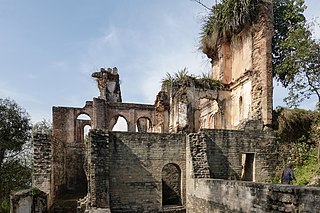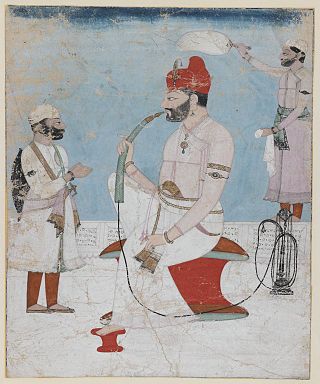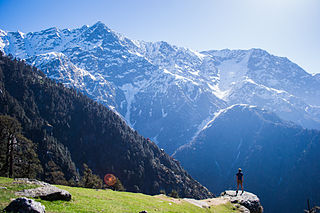
Hamirpur district is in the Indian state of Himachal Pradesh. The headquarters of the district are in the town of Hamirpur. With an area of 1,118 square kilometres or 432 square miles, it is the smallest district of Himachal Pradesh.

Kangra-Lambagraon was a historical princely estate (jagir) of British India located in the present-day state of Himachal Pradesh.

Kangra is a city and a municipal council in Kangra district in the Indian state of Himachal Pradesh. It is also known as Nagarkot.
Katoch is a Chandravanshi Rajput clan with unbroken bloodline established in 4300B.C. There areas of residence are mainly in the Indian states of Himachal Pradesh, Jammu, Punjab, and Uttarakhand. Traditionally resided in Kangra Fort, Trigarta Kingdom, Jalandhar, Multan.

Trigarta kingdom was an ancient Indo-Aryan kingdom of western South Asia whose existence is attested during the Iron Age. It had its capitals at Prasthala, Multan and Kangra.

Sansar Chand was a Rajput ruler of the erstwhile Kangra State in what is now the Indian state of Himachal Pradesh.

The Kangra fort is a historic fort located in the Kangra district of the Himachal Pradesh state, India. This fort is also known as 'Nagarkot' and 'Kot Kangra'. This fort stands on a hillock between two rivers, among the foothills of the Dhauladhar range. This fort is the largest in the Indian Himalayas, and is under the protection of the Archeological Survey of India.

Jawalamukhi, or Jwalamukhi also Jawalaji, is a temple town and a nagar parishad in Kangra district in the Indian state of Himachal Pradesh. Hindu genealogy registers are kept here like that of Haridwar. The town takes its name from the holy Jwalamukhi Temple, located in Jawalamukhi. Firuz Shah Tughlaq during his campaign of Nagarkot collected 1300 Sanskrit Manuscripts from this temple's library and got them translated into Persian language, becoming the first Sultan to do such translation.

Tira Sujanpur, also known as Sujanpur Tira or Sujanpur Tihra, is a town and municipal council in the Hamirpur district of Himachal Pradesh. Founded in the 18th century by the Katoch dynasty, the town is located midst the Himalayan foothills on the southern bank of the Beas River. It was one of the centers of Kangra-style miniature paintings and Hindu temples built in an unusual blend of conventional Nagara architecture shrines with Mughal architecture palace, the latter decorated with floral murals of legends from the Ramayana and the Mahabharata.

Chamba is a town in the Chamba district in the Indian state of Himachal Pradesh. According to the 2001 Indian census, Chamba has a population of 20,312 people. Located at an altitude of 1,006 metres (3,301 ft) above mean sea level, the town is situated on the banks of the Ravi River, at its confluence with the Sal River.

Himachal Pradesh was established in 1948 as a Chief Commissioner's Province within the Union of India. The province comprised the hill districts around Shimla and southern hill areas of the former Punjab region. Himachal became a part C state on 1951 with the implementation of the Constitution of India. Himachal Pradesh became a Union Territory on 1 November 1956. On 18 December 1970 the State of Himachal Pradesh Act was passed by Parliament and the new state came into being on 25 January 1971. Thus Himachal emerged as the eighteenth state of the Indian Union.

McLeod Ganj or McLeodganj is a suburb of Dharamshala in Kangra district, Himachal Pradesh, India. It is known as "Little Lhasa" or "Dhasa" as the Tibetan government-in-exile is headquartered here and there is a significant population of Tibetans in the region.
Jaswan was a precolonial Indian state centred at Rajpur Jaswan, in modern-day Punjab and Himachal Pradesh, commanded by the Jaswal Rajput clan. It was founded in 1170 AD by Raja Purab Chand, a cadet of the Katoch lineage, ancient royal family of Kangra.
Indora is a town that serves as a tehsil headquarter in the Kangra district at the borders of Himachal Pradesh, India along the dried Beas rivulet, to which Pathankot is a nearer city in plains of Punjab, while Nurpur, a town in Himachal, is farther in the hills. One can reach Indora by train up to Kandrori (KNDI) or Pathankot (PTX). Alternatively, the MDR 42 road passes through Indora connecting NH 44 with NH 503, nearest airport is Pathankot Airport.

Aadi Himani Chamunda is a Hindu temple dedicated to Shri Chamunda Devi, situated in Chandar Bhan, Jia in Kangra Valley, Himachal Pradesh, India, in the Himalayas.
Shamirpur is a town in the Kangra district of the Indian state of Himachal Pradesh. It is located next to National Highway 20, which runs from Pathankot in Punjab to Mandi in Himachal Pradesh. It is easily accessible from Dharmasala. The nearest airport is Gaggal Airport, alternatively known as Kangra Airport or Dharamsala-Kangra Airport, which is located in Gaggal near Kangra, 14 kilometres (8.7 mi) southwest of Dharamshala.

Nurpur kingdom in the Himalayan foothills of India was founded in 1064 A.D at north-eastern Bari Doab between the Ravi and the Beas rivers at the fusion of Kangra, Duggar, Majha, Dharab and Chamba areas which ended in 1815. The remnants of Nurpur kingdom exist as ruined forts, restored temples, water bodies, and canals in Nurpur tehsil, Fatehpur tehsil, Pathankot tehsil, Dhar Kalan tehsil, Jawali tehsil, Indora tehsil Bhattiyat tehsil, and Sihunta tehsil.
Ichhi is a village and a Village Panchayat in Kangra district in the Indian state of Himachal Pradesh. Ichhi village is 8 kilometres from Kangra.
Chandel or Chandela is a Rajput clan from India. Families belonging to this clan ruled several kingdoms in north India and held various feudal estates. The most notable of these were the Chandelas of Jejakabhukti, who ruled the Bundelkhand region.
Jubbal State was a non-salute state of the Simla Hill States Superintendency of the Punjab States Agency. Thought to have been founded in the twelfth century, it merged with the Indian Union in 1948.












